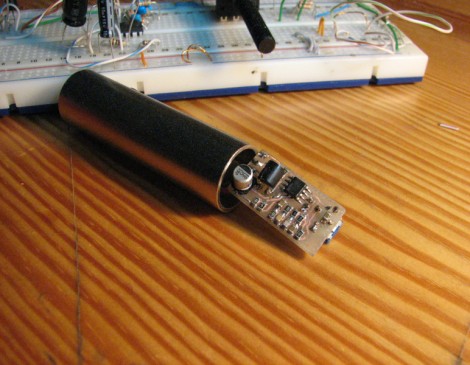
[Miceuz] just finished his first surface mount electronics project. It’s a pink noise generator that is used for testing audio equipment (scroll down that link for the English version of his writeup).
Pink noise is somewhere in between red noise and white noise. Didn’t realize there were more colors than just white when it comes to noise? The benefit of testing with pink noise is that it the power of the audio signal is stable through each octave of sound – white noise increases in power with each additional octave which can damage the tweeters in a sound system.
The goal in this design was to build a noise generator that fit into an XLR connector. [Miceuz] started with an existing design, and altered it to suit his needs. Much like a condenser microphone, the pink noise generator uses phantom power instead of a standalone power source. For instance, the design he based this on required two 9v batteries. The size, the choice of case, and the absence of a battery all spell WIN for this project.















Interesting, about ten years ago I made a microphone which fit into an XLR connector… nothing amazing, but it was fun learning to make my own stuff.
Interesting project, I will have to read up on it to see if it is true pink noise. Great link, thanks.
As for white noise, it is all frequencies at the same amplitude. We perceive it to sound higher pitched because it generally takes more amplitude in the lower frequencies to hear, plus our ears are naturally tuned ( think of our frequency response ) to the vocal range of 2-ish kHz – 4-ish kHz. That is why we notice babies crying, which is not by accident.
Oh, and to expand slightly, Pink noise is used to tune audio systems because it more closely follows our ear’s frequency response… though not perfectly.
Actually red noise is the same as pink noise. I’m a huge expert on this now because I looked it up on Wikipedia.
http://en.wikipedia.org/wiki/Colors_of_noise
There is also brown noise but a whole different thing comes to mind when I think of that.
Suddenly the song “Playing With Pink Noise” by Kaki King makes a lot more sense to me.
I think you got it a bit wrong there, pink noise is Decreasing in amplitude over the spectrum whilst white noise is stable. You usually achieve this by lowpass filtering white noise.
@Matt laughed at the “huge expert by wikipedia” thing haha
SimplyNoise has a noise generator on their website (as well as an iPhone app) that generates white, pink, and brown noise.
http://www.simplynoise.com/
I have more sensitive hearing when I’m working grave shifts (still haven’t figured that one out), and listening to pink noise with headphones helps get rid of it. I found out about pink noise through this website: http://www.hyperacusis.net/hyperacusis/4+types+of+sound+sensitivity/default.asp
I have reference implementations of pink, white, and brown noise available for download: http://www.jetcityorange.com/SoundFiles/noise.html
@Matt: funny, todays XKCD touches the same subject :-D
http://xkcd.com/903/